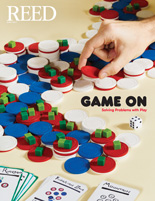
IRIS login | Reed College home Volume 96, No. 2: June 2017
Reedie's Vermeer film has Portland premiere

Tim Jenison with one of the experimental optical devices he built. Photo by Shane F. Kelly, Courtesy of Sony Pictures Classics.
The luminescent quality of Johannes Vermeer’s paintings has astonished viewers for 350 years. How did he achieve such incredible photorealism a century and a half before photography was invented?
That’s the question that drives the film Tim’s Vermeer, released this spring by Sony Pictures Classics and a high point of the 37th Portland International Film Festival. The documentary focuses on a Texas inventor named Tim Jenison who is obsessed with figuring out—and duplicating—Vermeer’s secret techniques. The film has received numerous nominations and awards, including 2014 BAFTA nomination for best documentary. For Farley Ziegler ’84, who produced the film in collaboration with the magical duo Penn and Teller, the project represents the consummate synthesis of art and science.
What Jenison knew of the use by Renaissance artists of optics and lenses—primarily the camera obscura—and the supposition that Vermeer also employed them, stemmed from his reading of David Hockney’s Secret Knowledge: Rediscovering the Lost Techniques of the Old Masters and Philip Steadman’s Vermeer's Camera: Uncovering the Truth behind the Masterpieces. Details about Vermeer’s method and much of his life (1632–75) in Delft were left unrecorded.
Led by insatiable curiosity, Jenison proposed an experiment: if Vermeer achieved the exceptional quality of light and dimension that distinguishes his work from other painters of his time by utilizing a machine, could a non-painter employ the technique and replicate a Vermeer?
Though passionate about electronics, music, film, and video, Jenison had never employed a paintbrush and undertook the challenge without the certainty of success. It was a “journey into obsession, no one was prepared for,” says Ziegler. Through incremental stages, characterized by both near failure and success, Jenison explored his supposition and transformed his theory. Physically and mentally exhausted at times, and increasingly obsessed with the process, he persevered. The achievement was profoundly personal, but was accompanied by an unexpected discovery that challenged accepted thinking about Vermeer in the art world.
Ziegler found a “wonderful boldness” in Jenison, who, being neither a painter nor an art historian, was able to view Vermeer’s work through a unique lens. “That he looked at the paintings differently, and, as a consequence, that they yielded different information, is so compelling!” It’s easy to stop looking and to stop asking questions when something seems apparent, Ziegler says. “Rigorous inquiry and the desire to challenge accepted modes of thought, rather than taking things at face value, track very closely with what I learned at Reed, or, more accurately, how I learned to learn at Reed.”
Describing herself as an ardent fan of the humanities with a great appreciation for interdisciplinary study, Ziegler majored in English at Reed, working with adviser Prof. Gail Pemberton [English 1983–84] and Prof. Rick Gray [German 1982–83] to complete the thesis “The Mysteries and Manners of Eudora Welty.” She also recalls favorably the courses taught by Prof. Bill Lankford [English 1977–81], Prof. Robert Segal [religion & humanities 1975–82], and Prof. Peter Steinberger [political science 1977–]. A “late bloomer” in her undergraduate years, Ziegler possessed confidence, an appetite for learning, and an eagerness to participate fully in the classroom in courses she took later in life—first in New York, and later at the Getty Museum and with T.C. Boyle at University of Southern California. “Much to my delight, my learning at Reed has turned out to be time-release.”
During the seven months that it took Jenison to paint, Ziegler, in Los Angeles, spoke daily and directly to him, in San Antonio, through a video Skype feed. The intimate quality of the Tim’s Vermeer—one of its outstanding features—comes directly from this communication. For the project, Ziegler also worked as a videographer, traveled with Jenison and the crew to England, Holland, San Antonio, and Las Vegas, and played an integral role in the editing done with Patrick Sheffield and Penn and Teller as they created an 80-minute story from 2400 hours of film.
Though the project was initiated from the standpoint of science, the framework of the film is built on the human experience, says Ziegler. Jenison’s search to uncover a technique leads him into the presence of the artist who created it. It is a journey that will resonate with anyone who has engaged in and answered to the demands of intellectual pursuit. And for everyone there is an unexpected gift that results from viewing Tim’s Vermeer, Ziegler says. It is a surge of enthusiasm to follow a one’s own passion—“and to never throw in the towel.”
Tim's Vermeer is now showing at Cinema 21 in Portland. Learn more about the movie, and find theatre showings nationwide.


LATEST COMMENTS
steve-jobs-1976 I knew Steve Jobs when he was on the second floor of Quincy. (Fall...
Utnapishtim - 2 weeks ago
Prof. Mason Drukman [political science 1964–70] This is gold, pure gold. God bless, Prof. Drukman.
puredog - 1 month ago
virginia-davis-1965 Such a good friend & compatriot in the day of Satyricon...
czarchasm - 4 months ago
John Peara Baba 1990 John died of a broken heart from losing his mom and then his...
kodachrome - 7 months ago
Carol Sawyer 1962 Who wrote this obit? I'm writing something about Carol Sawyer...
MsLaurie Pepper - 8 months ago
William W. Wissman MAT 1969 ...and THREE sisters. Sabra, the oldest, Mary, the middle, and...
riclf - 10 months ago